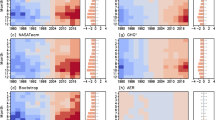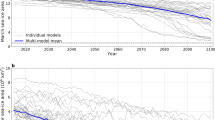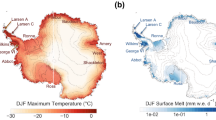Abstract
Arctic sea ice has declined rapidly with increasing global temperatures. However, it is largely unknown how Arctic summer sea-ice impacts would vary under the 1.5 °C Paris target compared to scenarios with greater warming. Using the Community Earth System Model, I show that constraining warming to 1.5 °C rather than 2.0 °C reduces the probability of any summer ice-free conditions by 2100 from 100% to 30%. It also reduces the late-century probability of an ice cover below the 2012 record minimum from 98% to 55%. For warming above 2 °C, frequent ice-free conditions can be expected, potentially for several months per year. Although sea-ice loss is generally reversible for decreasing temperatures, sea ice will only recover to current conditions if atmospheric CO2 is reduced below present-day concentrations. Due to model biases, these results provide a lower bound on summer sea-ice impacts, but clearly demonstrate the benefits of constraining warming to 1.5 °C.
This is a preview of subscription content, access via your institution
Access options
Access Nature and 54 other Nature Portfolio journals
Get Nature+, our best-value online-access subscription
$29.99 / 30 days
cancel any time
Subscribe to this journal
Receive 12 print issues and online access
$209.00 per year
only $17.42 per issue
Buy this article
- Purchase on Springer Link
- Instant access to full article PDF
Prices may be subject to local taxes which are calculated during checkout




Similar content being viewed by others
Change history
05 August 2019
An amendment to this paper has been published and can be accessed via a link at the top of the paper.
References
Gregory, J. M. et al. Recent and future changes in Arctic sea ice simulated by the HadCM3 AOGCM. Geophys. Res. Lett. 29, 2175 (2002).
Winton, M. Do climate models underestimate the sensitivity of Northern Hemisphere sea ice cover? J. Clim. 24, 3924–3934 (2011).
Mahlstein, I. & Knutti, R. September Arctic sea ice predicted to disappear near 2 °C global warming above present. Geophys. Res. Lett. 117, D06104 (2012).
Ridley, J. K., Lowe, J. A. & Hewitt, H. T. How reversible is sea ice loss? Cryosphere 6, 193–198 (2012).
Li, C., Notz, D., Tietsche, S. & Marotzke, J. The transient versus the equilibrium response of sea ice to global warming. J. Clim. 26, 5624–5636 (2013).
Stroeve, J. & Notz, D. Insights on past and future sea-ice evolution from combining observations and models. Glob. Planet. Change 135, 119–132 (2015).
Rosenblum, E. & Eisenman, I. Faster Arctic sea ice retreat in CMIP5 than in CMIP3 due to volcanoes. J. Clim. 29, 9179–9188 (2016).
Notz, D. & Marotzke, J. Observations reveal external driver for Arctic sea-ice retreat. Geophys. Res. Lett. 39, L08502 (2012).
Jahn, A. & Holland, M. M. Implications of Arctic sea ice changes for North Atlantic deep convection and the meridional overturning circulation in CCSM4-CMIP5 simulations. Geophys. Res. Lett. 40, 1206–1211 (2013).
Notz, D. & Stroeve, J. Observed Arctic sea-ice loss directly follows anthropogenic CO2 emission. Science 354, 747–750 (2016).
Adoption of the Paris Agreement FCCC/CP/2015/L.9/Rev.1 (UNFCCC, 2015).
Holland, M. M., Bitz, C. M. & Tremblay, B. Future abrupt reductions in the summer Arctic sea ice. Geophys. Res. Lett. 33, L23503 (2006).
Boe, J., Hall, A. & Qu, X. September sea-ice cover in the Arctic Ocean projected to vanish by 2100. Nat. Geosci. 2, 341–343 (2009).
Wang, M. & Overland, J. E. A sea ice free summer Arctic within 30 years? Geophys. Res. Lett. 36, L07502 (2009).
Stroeve, J. C. et al. Trends in Arctic sea ice extent from CMIP5, CMIP3 and observations. Geophys. Res. Lett. 39, L16502 (2012).
Massonnet, F. et al. Constraining projections of summer Arctic sea ice. Cryosphere 6, 1383–1394 (2012).
Overland, J. E. & Wang, M. When will the summer Arctic be nearly sea ice free? Geophys. Res. Lett. 40, 2097–2101 (2013).
Jahn, A., Kay, J. E., Holland, M. M. & Hall, D. M. How predictable is the timing of a summer ice-free Arctic? Geophys. Res. Lett. 43, 9113–9120 (2016).
Screen, J. A. & Williamson, D. Ice-free Arctic at 1.5 °C? Nat. Clim. Change 7, 230–231 (2017).
Sanderson, B. M. et al. Community climate simulations to assess avoided impacts in 1.5 °C and 2 °C futures. Earth Syst. Dynam. 8, 827–847 (2017).
Kay, J. E. et al. The Community Earth System Model (CESM) Large Ensemble Project: a community resource for studying climate change in the presence of internal climate variability. Bull. Am. Meteorol. Soc. 96, 1333–1349 (2015).
Sanderson, B. M., Oleson, K. W., Strand, W. G., Lehner, F. & O'Neill, B. C. A new ensemble of GCM simulations to assess avoided impacts in a climate mitigation scenario. Climatic Change 146, 303–318 (2018).
Rosenblum, E. & Eisenman, I. Sea ice trends in climate models only accurate in runs with biased global warming. J. Clim. 30, 6265–6278 (2017).
Laidre, K. L. et al. Quantifying the sensitivity of arctic marine mammals to climate-induced habitat change. Ecol. Appl. 18, S97–S125 (2008).
Kovacs, K. M., Moore, S., Overland, J. E. & Lydersen, C. Impacts of changing sea ice conditions on Arctic marine mammals. Mar. Biodivers. 41, 181–194 (2011).
Regehr, E. V., Lunn, N. J., Amstrup, S. C. & Stirling, I. Effects of earlier sea-ice breakup on survival and population size of polar bears in western Hudson Bay. J. Wildlife Manage. 71, 2673–2683 (2007).
Regehr, E. V., Hunter, C. M., Caswell, H., Amstrup, S. C. & Stirling, I. Survival and breeding of polar bears in the southern Beaufort Sea in relation to sea-ice. J. Anim. Ecol. 79, 117–127 (2010).
Overeem, I. et al. Sea ice loss enhances wave action at the Arctic coast. Geophys. Res. Lett. 38, L17503 (2011).
Barnhart, K. R., Miller, C. R., Overeem, I. & Kay, J. E. Mapping the future expansion of Arctic open water. Nat. Clim. Change 6, 280–285 (2015).
Fetterer, F., Knowles, K., Meier, W., Savoie, M. & Windnagel, A. K. Sea Ice Index, Version 3 (National Snow and Ice Data Center, 2017).
Parkinson, C. L. & Comiso, J. C. On the 2012 record low Arctic sea ice cover: combined impact of preconditioning and an August storm. Geophys. Res. Lett. 40, 1356–1361 (2013).
IPCC Climate Change 2013: The Physical Science Basis (eds Stocker, T. F. et al.) (Cambridge Univ. Press, 2013).
Mitchell, D. et al. Realizing the impacts of a 1.5 °C warmer world. Nat. Clim. Change 6, 735–737 (2016).
Armour, K. C., Eisenman, I., Blanchard-Wrigglesworth, E., McCusker, K. E. & Bitz, C. M. The reversibility of sea ice loss in a state of the art climate model. Geophys. Res. Lett. 38, L16705 (2011).
Kay, J. E., Holland, M. M. & Jahn, A. Inter-annual to multi-decadal Arctic sea ice extent trends in a warming world. Geophys. Res. Lett. 38, L15708 (2011).
Jahn, A. et al. Late 20th century simulation of Arctic sea ice and ocean properties in the CCSM4. J. Clim. 25, 1431–1452 (2012).
Swart, N. C., Fyfe, J. C., Hawkins, E., Kay, J. E. & Jahn, A. Influence of internal variability on Arctic sea-ice trends. Nat. Clim. Change 5, 86–89 (2015).
Notz, D. How well must climate models agree with observations?. Phil. Trans. R. Soc. A 373, 20140164 (2015).
DeRepentigny, P., Tremblay, L. B., Newton, R. & Pfirman, S. Patterns of sea ice retreat in the transition to a seasonally ice-free Arctic. J. Clim. 29, 6993–7008 (2016).
Kirchmeier-Young, M. C., Zwiers, F. W. & Gillett, N. P. Attribution of extreme events in Arctic sea ice extent. J. Clim. 30, 553–571 (2017).
GISS Surface Temperature Analysis (GISTEMP) (NASA Goddard Institute for Space Studies, accessed 7 February 2017); https://data.giss.nasa.gov/gistemp/
Hansen, J., Ruedy, R., Sato, M. & Lo, K. Global surface temperature change. Rev. Geophys. 48, RG4004 (2010).
HadCRUT.4.5.0.0 Near Surface Temperature Data (Met Office Hadley Centre, accessed 7 February 2017); www.metoffice.gov.uk/hadobs/hadcrut4/data/current/download.html
Morice, C. P., Kennedy, J. J., Rayner, N. A. & Jones, P. D. Quantifying uncertainties in global and regional temperature change using an ensemble of observational estimates: the HadCRUT4 dataset. J. Geophys. Res. 117, D08101 (2012).
Global Surface Temperature Anomalies (National Climatic Data Center, accessed 7 February 2017); www.ncdc.noaa.gov/cag/global/time-series/globe
Vose, R. S. et al. NOAA's merged land–ocean surface temperature analysis. Bull. Am. Meteorol. Soc. 93, 1677–1685 (2012).
Acknowledgements
This work was funded by CU and NSF OPP grant no. 1504348. I thank J. Kay, D. M. Hall and F. Massonnet for valuable feedback on an earlier version of the manuscript, E. Rosenblum for sharing her CMIP5 SIEs and temperatures, D. Notz, S. Sigmond, B. Sanderson and the CESM Polar Climate Working Group members for useful discussions, and the PIs and members of the three CESM1.1 ensemble projects for planning and running the ensembles and freely sharing the output. The CESM project is supported by the NSF and the Office of Science (BER) of the US Department of Energy. Computing resources for the CESM ensembles were provided by the Climate Simulation Laboratory at NCAR’s Computational and Information Systems Laboratory, sponsored by the NSF and other agencies. Five of the CESM LE simulations were produced at the University of Toronto under the supervision of P. Kushner. NCL was used for data analysis.
Author information
Authors and Affiliations
Contributions
A.J. designed the study, performed the analysis, and wrote the manuscript.
Corresponding author
Ethics declarations
Competing interests
The author declares no competing interests.
Additional information
Publisher’s note: Springer Nature remains neutral with regard to jurisdictional claims in published maps and institutional affiliations.
Supplementary information
Supplementary Information
Additional ice-free definitions, Supplementary Figures 1–5 and Supplementary References
Rights and permissions
About this article
Cite this article
Jahn, A. Reduced probability of ice-free summers for 1.5 °C compared to 2 °C warming. Nature Clim Change 8, 409–413 (2018). https://doi.org/10.1038/s41558-018-0127-8
Received:
Accepted:
Published:
Issue Date:
DOI: https://doi.org/10.1038/s41558-018-0127-8
This article is cited by
-
The phase change in the annual cycle of sea surface temperature
npj Climate and Atmospheric Science (2024)
-
Projections of an ice-free Arctic Ocean
Nature Reviews Earth & Environment (2024)
-
Projecting Wintertime Newly Formed Arctic Sea Ice through Weighting CMIP6 Model Performance and Independence
Advances in Atmospheric Sciences (2024)
-
Atmospheric circulation-constrained model sensitivity recalibrates Arctic climate projections
Nature Climate Change (2023)
-
A frequent ice-free Arctic is likely to occur before the mid-21st century
npj Climate and Atmospheric Science (2023)



